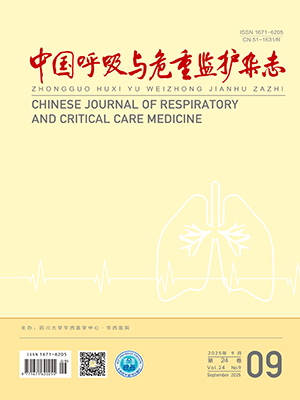Objective To evaluate the rescue intubation induced by ketamine and midazolam in patients with acute respiratory failure.
Methods 81 patients with acute respiratory failure admitted between June 2010 and June 2012 were recruited in the study. They were randomly divided to a MF group to receive 0. 05 mg/kg of midazolam + 1 to 2 μg/kg of fentanyl ( n =41) , and aMK group to received 0. 05 mg/kg of midazolam + 0. 5 to 1 mg/kg of ketamine ( n =40) for rescue intubation. The APACHEⅡ score on initial
24 hours after admission in ICU, length of ICU stay, and 28-day mortality were recorded. The differences in arterial blood pressure, heart rate, respiration rate, and blood oxygen saturation before intubation and 10 minutes after intubation were compared. Incidences of hypotension and other adverse events and difficult intubation were also recorded.
Results The midazolamdose in the MK group was significantly less than that in the MF group ( P lt; 0. 01) . The blood pressure in both groups decreased. The systolic blood pressure dropped most significantly in the MF group ( P lt;0. 05) . The incidence of hypotension was 41. 5% in the MF group, significantly higher than that in the MK group ( 20. 0% , P lt;0. 05) . The incidence of hypotension had no correlation with midazolamdosage ( P gt;0. 05) . There was no significant difference in adverse events except for the arrhythmia between two groups. The length of ICU stay and 28-day mortality were similar in both groups ( P gt; 0. 05) . The incidence of difficult tracheal intubation was nearly 50% in both groups.
Conclusions In patients with respiratory failure, rescue intubation induced by ketamine can reduce the dose of midazolam and reduce the incidence of hypotension without more complications. The optimal dose of ketamine in induced tracheal intubation requires further study.
Citation: YANG Mingquan,LI Qiang,XIAO Guohui,ZHENG Gang,ZHOU Chuanzheng,ZHOU Jie,CAO Jianwei,TAN Xiaofei.. Clinical Evaluation of Induced Rescue Intubation by Ketamine and Midazolam in Patients with Respiratory Failure. Chinese Journal of Respiratory and Critical Care Medicine, 2013, 12(5): 477-480. doi: DOI: 10 . 7507 /1671 -6205 . 20130115 Copy
Copyright © the editorial department of Chinese Journal of Respiratory and Critical Care Medicine of West China Medical Publisher. All rights reserved




